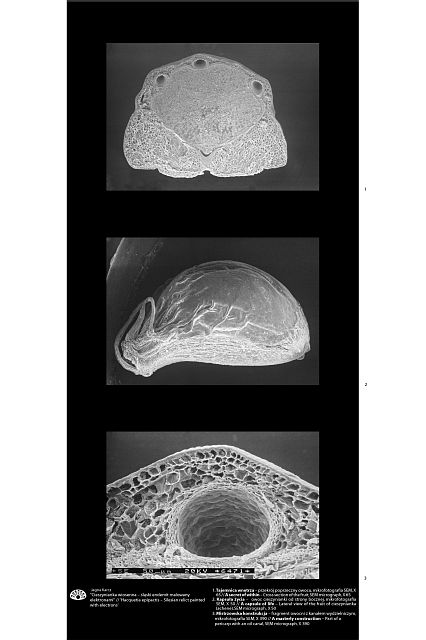 |
'Hacquetia epipactis - Silesian relict painted with electrons'
'Structure and histochemistry of fruit of Hacquetia epipactis (Scop.) DC. (Apiaceae)' JAGNA KARCZ1, JAN BURCZYK2 (authors of photograph)
1 University of Silesia, Faculty of Biology and Environmental Protection,
Laboratory of Scanning Electron Microscopy; Jagiellońska 28, 40-032 Katowice
e-mail: jmkarcz@us.edu.pl
2 Medical University of Silesia
Faculty of Ppharmacy and Division of Laboratory Medicine
Department of Pharmacognosy and Phytochemistry; Jagiellońska 4, 41-200 Sosnowiec
|

Description popularizing the research project
When a legendary hero, whose destiny had led him to Cieszyn, died in battle, his friends took his pouch filled with soil from his country and sprinkled it over his grave. The legend has it that the following spring an unknown flower bloomed there. To date in the forests near Cieszyn you can find the small inconspicuous plant. It blooms as one of the first plants in March. Hacquetia epepactis as it is its name rarely grows in other parts of Poland and when it sheds blossom it is hard to find in the rich undergrowth of broadleaved forests. Although unlike in the legend scientists associate its origin with the receding continental glacier after the last Pleistocene glaciations, for the people of the region it will certainly remain a symbol of love to a mother country.
To protect the species several reserves were established and the plant itself and its fruit underwent meticulous examinations. SEM observations of the fruit revealed surprisingly elaborate internal structure. Maybe it will explain why Hacquetia epepactis is so difficult to reproduce in laboratories and gardens. It is a dream of botanists who would like to save the endangered species, but of pharmacologists as well, as in the cells of the fruit they discovered precious active substances.
Meanwhile the rare plant called by botanists a 'migrating relict' prefers only its forest with its specific microclimate, soil and dense thickets where more secrets lay hidden.
Abstract
Cieszynianka wiosenna Hacquetia epipactis (Scop.) DC. is the only species of the genus Hacquetia, growing sporadically in South Poland. Currently, this species is rare and endangered in several natural stands in the area of the Upper Silesia: the Moravian Gate (municipal forest "Obora" in Raciborz, Rozumice, Bełsznica) and in the region of the Pogórze Cieszyńskie (Kopce/Cieszyn). In addition, this species is very difficult to reproduce in laboratory and garden conditions.
There is almost no information about Hacquetia epipactis in the carpological literature. So present studies were undertaken to examine the micromorphology and anatomy of fruits of H. epipactis with the aim of providing new diagnostic features for characterizing of this species. Fruits of H. epipactis at different developmental stages were collected from plant populations around Cieszyn and Raciborz. For SEM observations, air-dried, ripe fruits were examined and photographed with a Tesla BS 340 scanning electron microscope. SEM studies of the fruit surface demonstrated the existence of micromorphological diversity of epidermal cells. Moreover, the fruit cellular patterns were uniform within Hacquetia species both at an inter- and intra-population level. The anatomical study of the fruits showed that the development of the seed and its embryo as well as the synthesis of reserve materials follow before the final pericarp structure in an immature fruit is developed.
This may be used practically in germination physiology. Because of the fact that Hacquetia fruit contains biologically active secondary products, it is also important from a pharmacognostical point of view. More recently, Burczyk et al. (2005) examined mature fruits of Hacquetia for the presence of phenolic acids. These compounds may possess various pharmacological and biological activities. In conclusion, fruit structural characteristics may provide criteria useful for delimitation of species, and also for the identification of isolated fruits.

